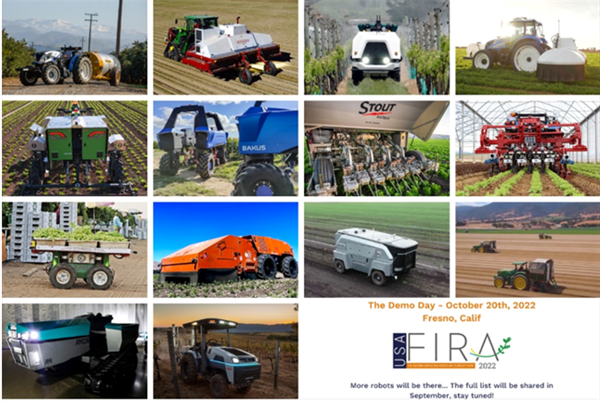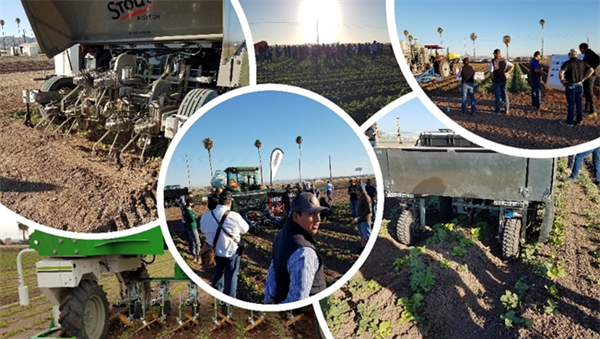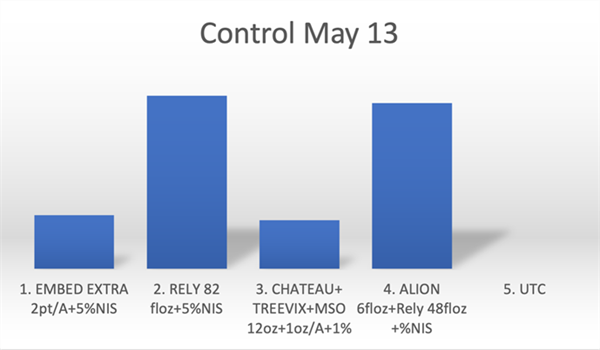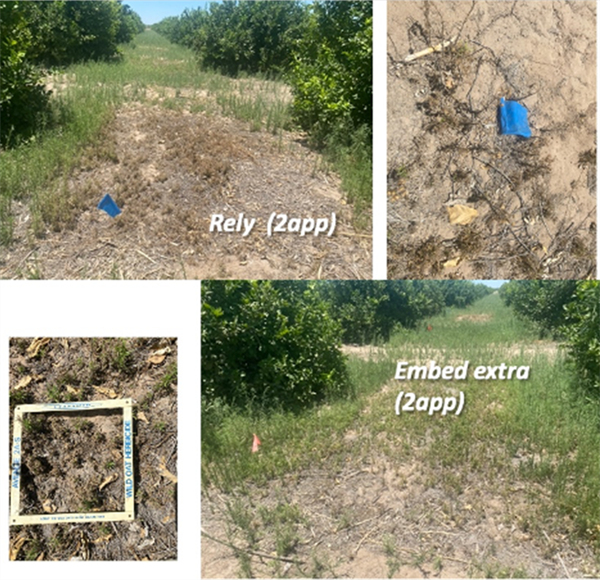



This study was conducted at the Yuma Valley Agricultural Center. The soil was a silty clay loam (7-56-37 sand-silt-clay, pH 7.2, O.M. 0.7%). Spinach ‘Meerkat’ was seeded, then sprinkler-irrigated to germinate seed Jan 13, 2025 on beds with 84 in. between bed centers and containing 30 lines of seed per bed. All irrigation water was supplied by sprinkler irrigation. Treatments were replicated four times in a randomized complete block design. Replicate plots consisted of 15 ft lengths of bed separated by 3 ft lengths of nontreated bed. Treatments were applied with a CO2 backpack sprayer that delivered 50 gal/acre at 40 psi to flat-fan nozzles.

Downy mildew (caused by Peronospora farinosa f. sp. spinaciae)was first observed in plots on Mar 5 and final reading was taken on March 6 and March 7, 2025. Spray date for each treatments are listed in excel file with the results.
Disease severity was recorded by determining the percentage of infected leaves present within three 1-ft2areas within each of the four replicate plots per treatment. The number of spinach leaves in a 1-ft2area of bed was approximately 144. The percentage were then changed to 1-10scale, with 1 being 10% infection and 10 being 100% infection.
The data (found in the accompanying Excel file) illustrate the degree of disease reduction obtained by applications of the various tested fungicides. Products that provided most effective control against the disease include Orondis ultra, Zampro, Stargus, Cevya, Eject .Please see table for other treatments with significant disease suppression/control. No phytotoxicity was observed in any of the treatments in this trial.
Interested in the latest ag technologies? There are a couple of events coming up next month that are worth reminding everyone about. The first is FIRA USA which is a 3-day event being held October 18-20th in Fresno, CA. The focus is on autonomous farming and agricultural robotics solutions. The event includes top-level keynote speakers, breakout sessions, a trade show and in-field demos of automated/robotic harvesting, weeding and planting equipment. The emphasis is on specialty crops, many related to vegetable crop production so it looks to be an informative program. For more information, click here or on the image below.
If you are unable to attend FIRA USA, another option is the University of Arizona’s 3rd AgTech Field Day. The event will be held Tuesday, October 25th at the University of Arizona’s Yuma Agricultural Center. The program will feature many of the technologies presented at FIRA being demoed in the field.
As mentioned in the previous issue, we’d like to showcase as many innovative ag technologies as possible at our UA Field Day. There is still room on the program, so please contact me if you are interested in demoing your equipment or know someone that is. It’s an open invitation - private companies, and university and government researchers are all welcome!

Fig. 1. FIRA-USA conference held October 17-20th in Fresno, CA.
(Photo credits: FIRA-USA).

Fig. 2. The University of Arizona’s 3rd AgTech Field Day will be held Oct. 25th,
2022, at the Yuma Agricultural Center, Yuma, AZ. (Photo from UA’s 2nd AgTech
Field Day held in 2021).
Overreliance in glyphosate could increase the risk of reduced efficacy of this herbicide. Some the weeds difficult to control with glyphosate in our area are: Hairy fleabane (Coniza bonariensis), Horseweed (Coniza canadiensis), White sweet clover (Melilotus albus). Pig weed (Amaranthus palmeri), and Cheeseweed (Malva parviflora). We are conducting experiments in the Yuma area to identify effective herbicide control options for Hairy fleabane. Some research done in Australia has shown that Fleabane cannot be controlled with a single herbicide treatment even with knockdown herbicides such as paraquat + diquat, and researchers suggest the need of combinations of different modes of action to achieve control effectively1. In one fleabane evaluation started May 6, 2022, we included the following treatments: 1. Embed Extra 2pt/A+5%NIS 2. Rely 82 floz+5%NIS 3. Chateau+ Treevix+MSO (12oz+1oz/A+1%)


We noticed treatments including Glufosinate (Rely) showed best burndown activity, but regrowth was observed in two weeks (13-14 plants per ft2). So, a second application was performed on three weeks after first on the Rely plots.
The grower and PCA informs us that Sulfenacil (Sharpen) has worked effectively for them with sequential applications. Additionally, we are evaluating Suppress and Clopyralid in the same location.
You are always welcomed to send your comments, suggestions to the IPM Team. Let us know what you are doing and your findings. We know there is a researcher in every grower and PCA and your input is greatly appreciated.

Results of pheromone and sticky trap catches can be viewed here.
Corn earworm: CEW moth counts down in all traps over the last month; about average for December.
Beet armyworm: Moth trap counts decreased in all areas in the last 2 weeks but appear to remain active in some areas, and average for this time of the year.
Cabbage looper: Moths increased in the past 2 weeks, and average for this time of the season.
Diamondback moth: Adults increased in several locations last, particularly in the Yuma Valley most traps. Below average for December.
Whitefly: Adult movement remains low in all areas, consistent with previous years
Thrips: Thrips adult movement continues to decline, overall activity below average for December.
Aphids: Winged aphids still actively moving but declined movement in the last 2 weeks. About average for December.
Leafminers: Adult activity down in most locations, below average for this time of season.